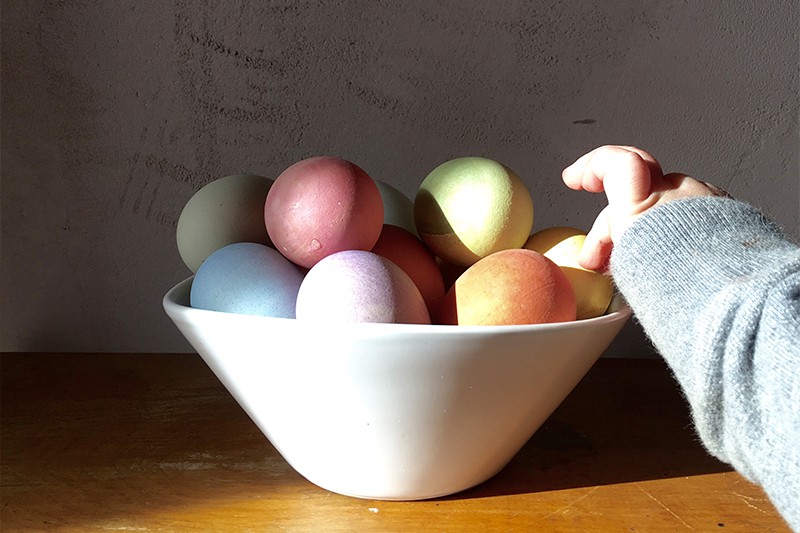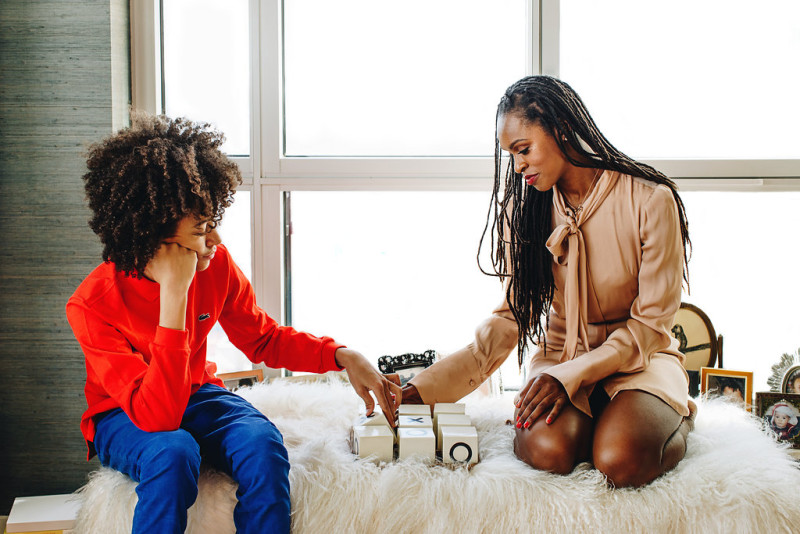
The Many Benefits Of Roughhousing With Your Kids
Written by Katie Hintz-Zambrano
Photography by Araks Yeramyan, Photographed by Maria Del Rio
With nearly a year of sheltering in place under many of our belts, things at home can start to feel stagnant. We’re often moving less, and so are our kids. One solution (with a whole lot of benefits) is making a daily or weekly habit out of getting physical in the form of gentle roughhousing with your kiddos.
If you’ve seen the flicker of delight and joy in your children’s eyes when engaging in a pillow fight, tickle session, dueling with foam swords, or the like, you might already have an inkling as to the benefits of roughhousing. As it turns out, they are impressively numerous.
To boil down the positive science behind rough and tumble play, we spoke with Anthony T. DeBenedet, M.D., the author of The Art of Roughhousing: Good Old-Fashioned Horseplay and Why Every Kid Needs It. An Ann Arbor-based gastroenterologist/internist by day and also the father of three girls (aged 10, 12, and 14), DeBenedet breaks down roughhousing benefits into two categories: intelligence (which he divides into three sub-categories) and connection. Go deeper into both, below.
Roughhousing Aids Intelligence:
Brain Smarts: “Brain smarts and IQ really boil down to memory and problem solving. The peak development for brain development for children is around that 8/9/10-year-old mark. That’s when neural connections and neural pathways (how different parts of the brain talk to each other) are being formed, which leads to the development of divergent thinking. Divergent thinking is about approaching a problem using your background, but also being able to approach a problem in a new and open way and not let your background hold you back. There’s an important chemical called brain-derived neurotrophic factor (BDNF), which s essentially fertilizer for a growing child’s brain. BDNF is released in some physical activities, but especially physical activities that involve another person, like an adult. This chemical is considered one of the top three chemicals helping brain development and it’s released a lot in rough and tumble play. There’s been a lot of research in the 1970s and early 1980s that the best predictor of school success in elementary school, more so than test scores and grades, is how much and how healthy a kid was engaging in physical play and rough and tumble play at home.”
Emotional Intelligence: “If you think about emotional intelligence, there are two parts to it—knowing your own emotions and being able to sense the emotions of other people. Roughhousing is really phenomenal for that. It’s a lot of body language and non-verbal communication. As you’re roughhousing with your kids, they are learning to sense your emotions—they’re learning to read your facial expressions and when you might feel like it’s a little too intense for you. They’re learning to read when you’re having fun and when they might hurt you. That kind of skill set translates to when they’re older and and can read the emotions of other people. The other part is being able to understand their own emotions. An important point to note is that roughhousing should follow a natural arch. There needs to be a wind-up period and then a wind-down period. The wind-down period is often too fast. When the energy level is at peak intensity, most adults say, ‘Whoa, it’s getting too intense, it’s getting too violent, we need to stop.’ But when kids have a high level of emotional energy and they suddenly stop, they don’t know what to do with it. And that works as a disadvantage to their development. So, when you feel like it might be getting too high or too intense, have a way of winding down and moving down that natural arch again. Think about having an emotional dimmer switch, not just an on/off switch. We want kids to understand when their emotions are really high and how to take them down slowly. When roughhousing follows that natural arch, it can create that emotional dimmer switch, which is beneficial throughout childhood and adult life.”
Social Intelligence: “The notion of social intelligence is about knowing when to be a leader and when to be a follower. We talk a lot in society about creating leaders, but I think we should be raising kids to be both—knowing how to be a leader when their skill set is needed, and knowing when to be a follower when the team needs some followers on it. Roughhousing is great in this sense because in good, healthy roughhousing, the stronger person self-handicaps in order to allow the play to be fluid and improvisational. Roughhousing is a give and take, there’s a role reversal that’s always happening, and one person is not always the leader. Adults or the stronger kid holds back their full strength, and kids see that and get it. They see that that’s how it works and that makes it fun. Those are the seeds of social intelligence.”
Roughhousing Builds Connection:
“The crown jewel of rough and tumble play is building connection with your kids. The big hormone for connection is oxytocin, the love chemical and the trust chemical. Oxytocin is the biological basis of empathy. When we give someone a genuine hug, that oxytocin is released in both person’s brains. It’s even sometimes released with a handshake or fist bump. And when roughhousing is done in that give-and-take way, that bonding hormone is being released. When you’re doing steamroller with your kid or having them ride on your back, if you think of the mentality of connection, roughhousing is a great ways to do that. With boys it’s impactful in that we can teach them there’s more to physicality than sex and violence. We teach them about a joyful, physical, playful touch. Girls also learn to have a strong voice, as there are moments during roughhousing that you have to be vocal and speak up for what you want.”
Additional Tips:
*Roughhousing Changes With Age. “There’s roughhousing that you know what it is when you see it—the typical pillow fight stuff, rolling around on the ground, doing steam roller, or sandwich on the couch. The peek age for that is 2-6. As kids get older, the physical play changes a lot, and becomes more about physical challenges. It’s almost like Survivor. You might be walking across the street and see if you can balance on a parking beam, see who can jump over the picnic table, etc.”
*Start Slow. “Be sure to tune in. If your child is playing happily with a toy, don’t just come in and interrupt everything. Tune in instead of swooping in. Don’t start out at 60mph, ease into it, and think about that aforementioned natural arch with a wind-up and wind-down period.”
*Aggressive Behavior. “It can be a fine line of when roughhousing turns into violence. The biggest thing is eye contact. When you see your kid starting to get out of control, you’re going to lose eye contact. That’s what happens in the animal world, too, it turns into rage. What you have to do is redirect and say, ‘Hey, look me in the eyes. Where are my eyes?’ and kids will think that’s kind of funny. That brings the connection back and the idea that we’re having fun here and there’s no competition.”
*Get Creative, Goofy, & Involved. “If you’re going to a bounce house with your kids, take off your shoes and get in there. Even just a few seconds of your child seeing you behave in that way and let down your guard is huge. Be goofy and fall down. When in doubt, just fall down! Kids want to see you vulnerable. They want to see you fall down and not always have the right answers all the time.”
*Follow the Giggles. “The joke gets old for you a lot quicker than it does for them. So, just keep doing it. If they are laughing and think what you’re doing is hilarious, no need to change it. Just be a broken record and keep it going.”
*Keep it Win-Less. Most kids under 5 have a hard time losing. So, adults should bag the race. You do not win those games. Kids will eventually tell you when they are ready to start losing. They’ll say, ‘Mom, were you trying your hardest?’ And you say something like, ‘Do you want me to?’ and if they say yes, then they might be ready to lose.”
*Keep it Safe. “Knowledge equals safety. Make sure your perimeter is kind of secure. I have specific notes in my book about lifting appropriately and protecting joints. But injuries are really rare. There’s ER data that most childhood injuries are actually probably caused by children compensating on the playground for a lack of physical play in the house. These are kids who don’t get that outlet at home and then they get out on the playground and don’t know how to move their body, which leads to injuries.”
*Phantom Injuries. “Sometimes a child will stop and say ‘I’m hurt.’ And you can see they aren’t. Sometimes it’s a way for your child to say, ‘I’m not quite ready to forgive you for you getting home late, or not keeping a promise.’ So, when this happens, it’s a time to just emotionally be with your child. Stick a band-aid on the boo-boo. Band-aids are great emotional healers.”
For more on this topic, check out DeBenedet’s book The Art of Roughhousing: Good Old-Fashioned Horseplay and Why Every Kid Needs It. His follow-up book, Playful Intelligence: The Power Of Living Lightly In A Serious World, is focused on the importance of play in adulthood. DeBenedet also points to the book Big Body Play for additional research on roughhousing benefits for kids.
Share this story




